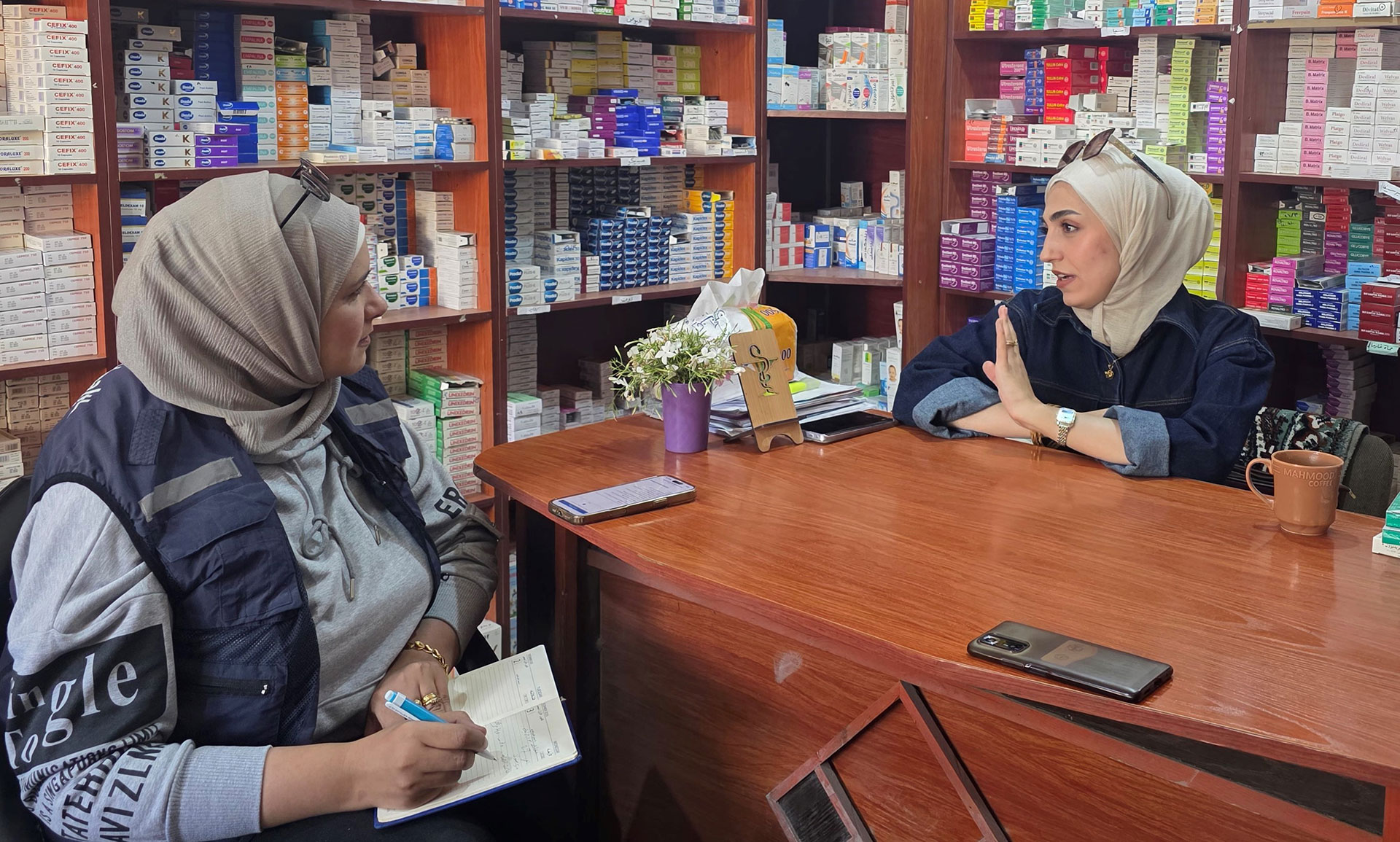Health workers in Syria raise awareness on the risks of antibiotic misuse – emro.who.int

Report on Antimicrobial Resistance (AMR) in the Syrian Arab Republic and its Implications for Sustainable Development Goals
Introduction: A Direct Threat to SDG 3 (Good Health and Well-being)
A report from Damascus, Syrian Arab Republic, dated 24 November 2025, indicates a growing threat from antimicrobial resistance (AMR) that directly undermines progress towards Sustainable Development Goal 3 (Good Health and Well-being). Healthcare professionals across the nation are witnessing an increase in infections that are difficult to treat, posing a significant risk to public health. The experiences of these frontline workers highlight systemic challenges, including difficult living conditions, which impede the responsible use of antibiotics and threaten the efficacy of essential medicines for future generations.
Key Drivers of AMR and Their Link to SDGs
Several interconnected factors contribute to the rise of AMR in Syria, linking directly to multiple Sustainable Development Goals.
- Economic Hardship and SDG 1 (No Poverty): Financial constraints prevent many individuals from affording medical consultations. This economic pressure, a barrier to overcoming poverty (SDG 1), forces them to purchase antibiotics without a prescription, leading to inappropriate use and fueling resistance.
- Public Misconceptions and Health Literacy (SDG 3): A prevalent belief among the populace is that antibiotics are a universal remedy for common ailments like fevers or colds. This gap in health understanding contributes to misuse and highlights the need for improved health education as a component of SDG 3.
- Irresponsible Consumption Patterns (SDG 12): The practice of using antibiotics without medical guidance, coupled with the failure to complete prescribed treatment courses, represents a pattern of irresponsible consumption. This behavior, along with limited prescription controls, directly contravenes the principles of SDG 12 (Responsible Consumption and Production).
Systemic and Environmental Factors: A One Health Perspective
The challenge of AMR extends beyond individual patient behavior, involving broader systemic and environmental issues that require a multi-sectoral “One Health” approach, touching upon several SDGs.
Challenges Identified:
- Infection Prevention and Control (IPC): Deficiencies in IPC within health facilities increase the incidence of infections, leading to a greater reliance on antibiotics and elevating the risk of resistant strains emerging. This is a critical challenge to ensuring quality healthcare under SDG 3.
- Agricultural Practices (SDG 12): The extensive use of antibiotics in livestock and agriculture contributes significantly to the AMR burden. Residues can contaminate the food chain and the environment, reflecting unsustainable production patterns targeted by SDG 12.
- Environmental Contamination (SDG 6): Antibiotic residues entering the environment through wastewater and soil compromise water quality and ecosystems. This highlights the urgent need for improved water and sanitation management, a core target of SDG 6 (Clean Water and Sanitation).
Impact on Vulnerable Populations
The consequences of AMR are most severe for vulnerable patient groups, particularly those with weakened immune systems, such as oncology and hematology patients. For these individuals, a minor infection can become life-threatening if effective antibiotics are not available. Clinicians in Homs and Aleppo report an increasing number of respiratory infections that are resistant to multiple standard antibiotics, making treatment prolonged, difficult, and sometimes ineffective. This reality presents a formidable obstacle to achieving the SDG 3 target of ensuring healthy lives for all.
Recommendations for Mitigating AMR in Alignment with the 2030 Agenda
To combat the threat of AMR and advance the Sustainable Development Goals, a coordinated strategy is essential. Based on frontline reports, the following actions are recommended:
- Strengthen Health Systems (SDG 3): Enhance the capacity of health centers to provide accessible and affordable care, ensuring a steady supply of appropriate medicines to reduce the need for self-medication.
- Promote Public Awareness (SDG 3 & SDG 12): Launch sustained awareness campaigns through schools and communities to educate the public on the correct use of antibiotics and the dangers of AMR, fostering responsible consumption.
- Enforce Stronger Regulation (SDG 12): Implement and enforce robust regulations to control the sale of antibiotics, restricting access without a valid prescription.
- Invest in Professional Training (SDG 3): Provide continuous education and training for all healthcare workers on AMR stewardship and best practices for infection control.
- Foster Multi-sectoral Collaboration (SDG 17): Adopt the One Health approach by strengthening partnerships between human health, animal health, and environmental sectors to create a unified front against AMR, embodying the spirit of SDG 17 (Partnerships for the Goals).
The collective effort to preserve the effectiveness of antibiotics in Syria is not only a public health imperative but also a critical component of achieving a sustainable and healthy future for all its citizens.
Analysis of Sustainable Development Goals in the Article
1. Which SDGs are addressed or connected to the issues highlighted in the article?
-
SDG 3: Good Health and Well-being
The article’s central theme is antimicrobial resistance (AMR), a major public health threat. It discusses the misuse of antibiotics, the challenges faced by health workers, the impact on patient treatment, and the need to strengthen health systems. All these points are directly related to ensuring healthy lives and promoting well-being.
-
SDG 6: Clean Water and Sanitation
The article explicitly links AMR to environmental factors, stating that “Antibiotics are widely used in livestock and agriculture, and residues can enter the environment through wastewater and soil.” This connects the issue to water quality and sanitation management, which are the core of SDG 6.
-
SDG 12: Responsible Consumption and Production
The article highlights issues of irresponsible consumption, such as the “random use of antibiotics” and patients “taking unprescribed medication.” It also touches upon production patterns by mentioning the widespread use of antibiotics in “livestock and agriculture,” calling for “better regulation of agricultural use.” This aligns with the goal of ensuring sustainable consumption and production patterns.
2. What specific targets under those SDGs can be identified based on the article’s content?
-
SDG 3: Good Health and Well-being
- Target 3.3: End the epidemics of… communicable diseases. The article addresses this target by focusing on AMR, which undermines the ability to treat infections. It notes that some infections are “becoming increasingly difficult to treat” and mentions “respiratory infections resistant to several antibiotics,” highlighting a direct threat to controlling communicable diseases.
- Target 3.8: Achieve universal health coverage, including access to quality essential health-care services and affordable essential medicines. The article points to barriers in accessing healthcare, noting that many people “cannot afford a visit” to a doctor, leading them to misuse antibiotics. It also calls for “ensuring steady availability of medicines and strengthening health centres” to provide the “right treatment at the right time.”
- Target 3.d: Strengthen the capacity… for early warning, risk reduction and management of national and global health risks. AMR is a global health risk. The article’s emphasis on “awareness campaigns,” “continuous training for health workers,” and “stronger regulation” are all measures aimed at strengthening the country’s capacity to manage this threat.
-
SDG 6: Clean Water and Sanitation
- Target 6.3: Improve water quality by reducing pollution… and minimizing release of hazardous chemicals and materials. The article identifies that antibiotic “residues can enter the environment through wastewater,” which is a form of chemical pollution. The call to address this through a “OneHealth approach — from clean water and waste management” directly relates to this target.
-
SDG 12: Responsible Consumption and Production
- Target 12.4: Achieve the environmentally sound management of chemicals and all wastes… and significantly reduce their release to air, water and soil. The article’s mention of antibiotic use in “livestock and agriculture” and their subsequent release into “wastewater and soil” connects directly to the need for sound management of these chemicals (antibiotics) to minimize environmental and health impacts.
3. Are there any indicators mentioned or implied in the article that can be used to measure progress towards the identified targets?
-
SDG 3: Good Health and Well-being
- Implied Indicator for Target 3.3: Prevalence of drug-resistant infections. The article describes “respiratory infections resistant to several antibiotics” and infections that are “difficult, lengthy, and sometimes ineffective” to treat. Tracking the frequency of such cases would be a direct measure of the AMR problem.
- Implied Indicator for Target 3.8: Proportion of the population purchasing antibiotics without a prescription due to financial hardship. The article states, “many are forced to seek antibiotics without consulting a doctor because they cannot afford a visit.” Measuring this practice would indicate the level of financial barriers to proper healthcare.
- Implied Indicator for Target 3.d: Number of health workers receiving training on AMR. The article repeatedly calls for “proper training for health workers” and “continuous training,” suggesting that the number of trained professionals is a key metric for building capacity.
-
SDG 6: Clean Water and Sanitation
- Implied Indicator for Target 6.3: Concentration of antibiotic residues in wastewater. The article’s statement that “residues can enter the environment through wastewater” implies that measuring the levels of these residues in water systems would be an indicator of pollution and progress in waste management.
-
SDG 12: Responsible Consumption and Production
- Implied Indicator for Target 12.4: Existence and enforcement of regulations on antibiotic use in agriculture. The call for “better regulation of agricultural use” suggests that the status of these regulations can serve as an indicator of progress towards responsible management of these chemicals in production systems.
4. Summary Table of SDGs, Targets, and Indicators
| SDGs | Targets | Indicators (Implied from the Article) |
|---|---|---|
| SDG 3: Good Health and Well-being |
3.3: End epidemics of communicable diseases.
3.8: Achieve universal health coverage and access to affordable essential medicines. 3.d: Strengthen capacity for management of national and global health risks. |
– Prevalence of infections resistant to standard antibiotics.
– Proportion of the population obtaining antibiotics without a prescription due to cost. – Number of health workers trained on responsible antibiotic use and AMR. |
| SDG 6: Clean Water and Sanitation | 6.3: Improve water quality by reducing pollution and minimizing the release of hazardous chemicals. | – Concentration of antibiotic residues measured in wastewater. |
| SDG 12: Responsible Consumption and Production | 12.4: Achieve environmentally sound management of chemicals and reduce their release to water and soil. | – Level of regulation and enforcement on antibiotic use in livestock and agriculture. |
Source: emro.who.int
What is Your Reaction?
 Like
0
Like
0
 Dislike
0
Dislike
0
 Love
0
Love
0
 Funny
0
Funny
0
 Angry
0
Angry
0
 Sad
0
Sad
0
 Wow
0
Wow
0



















































.jpg.webp?itok=0ZsAnae9#)
























